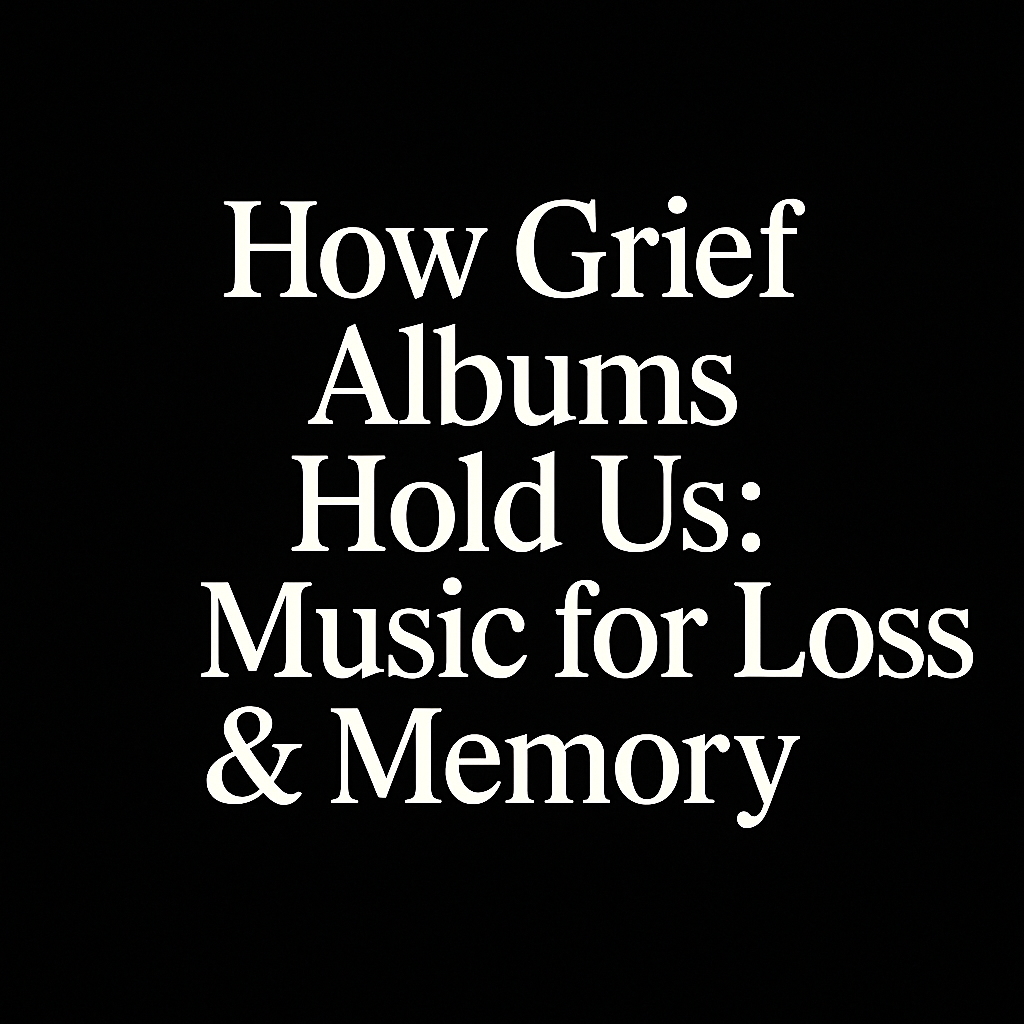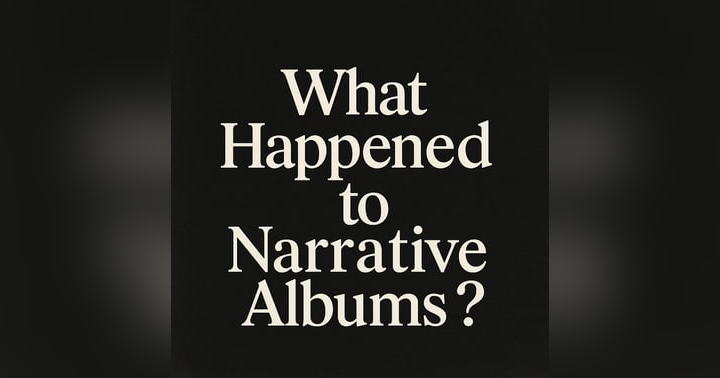How Grief Albums Hold Us: Music for Loss & Memory

There are songs that announce themselves like an arrival, and others that feel like the slow opening of a room’s curtains. Grief songs often belong to the latter; they ask you to enter, sit down, breathe the still air. They work by subtraction: a solitary instrument left to hang in a cavernous space, a voice so near it picks up your breath, an unresolved chord refusing the comfort of closure. Listening to these records is not about chasing a hook or chorus. It's about learning how to live with something that remains.
I want to begin with an image from film, because certain albums and cinema speak the same language of absence. In Krzysztof Kieślowski’s Three Colours: Blue, a woman survives a car crash that takes her husband and child. The film is patient, its frames white-hot. Sound is curated with surgical precision. The recurring score doesn’t heal, it becomes the landscape she inhabits, a sonic architecture of solitude. This is how albums that explore grief often function: not as remedies, but rooms where the wound is visible, and allowed to breathe.
Grief in music isn’t an emotion alone; it asks us to inhabit duration differently. Albums anchored in grief bend time. They slow tempo. They stretch reverb tails, so notes hang like dust motes. They trade complexity for small, human gestures: a repeated single-note figure, an off-hand line that names a small domestic object, the creak of a chair.
Arrangement as the Architecture of Absence:
There are a few artists I love that write about grief in a way that feels deeply personal to my own experience with it. Artists like Sufjan Stevens, Yebba and Mustafa (aka: Mustafa the Poet). Listen to Mustafa, and you can feel how restraint becomes instrument. His debut project, When Smoke Rises, and recently Dunya, use voice, guitar (and oud), and a whisper of ambient field recordings to suggest memory without narrating it. Silence is treated like another chord, negative space a palette. Each strum hue resonates like a memory turning back into view.
Sufjan Stevens builds his grief out of intimacy. Carrie & Lowell is a study in close-up. The recording sounds like someone singing into the pillow across from you. Reverb is short, the piano is brittle, the acoustic guitar picks at an obbligato that never competes with the lyric. Sufjan’s lyricism trades detail for gesture. Names, small domestic images, a few blunt truths, and that specificity anchors the wound to place and gives grief weight through life’s quiet details.
Bon Iver’s For Emma, Forever Ago employs cold production and thin, reedy vocals like an audio winter. Garbled harmonies, layered breaths, distant textures; it all evokes isolation. The listener becomes cocooned within the album’s sonic chill, experiencing grief not as performance, but as one’s own interior climate.
These are arrangement choices that recur across grief albums: slow tempi, restrained rhythmic attack, repeated simple motifs, and carefully calibrated silence. The effect is to create elasticity: a song elongates the moment of feeling so the listener can sit inside it without being hurried to a resolution.
Lyrical Strategy: Naming, Withholding, and Power in Specificity
Grief inhabits the personal and universal. Two lyrical devices make it poignant: naming and withholding.
Naming is radical because it insists on the existence of a person who is no longer present. Mustafa names. Even when the language is elliptical, the names are anchors: specific people, small domestic details, a plate, a scent. The named object or person makes absence legible. Naming is a small forensic act against the erasure that grief threatens.
Withholding, in contrast, universalizes. Sufjan’s use of “you” without detail turns the song into a communal mirror. Listeners place their own names, their own losses, into the spaces left open.
Phoebe Bridgers uses another trick: the juxtaposition of conversational detail with surreal image. She speaks in the cadences of speech. Dry, ironic, intimate, then drops into metaphors that are unexpectedly literal or oddly grotesque. That mix makes grief feel modern: awkward, sometimes funny, sometimes unbearably honest. Her work treats emotional dislocation as an everyday state. It’s how many of us experience loss: mundane routines laced with sudden, cinematic grief.
I like to imagine an album as a cast: each instrument plays a role. A layered vocal becomes memory refracted; the piano is a room’s furniture: it carries weight, but it also gets left untouched, its resonance indicating absence. A muted trumpet, the distant echo of closeness lost. The electric guitar is often the intruder; single notes that arrive like memory flashes. A cello or low-register brass can function as a kind of body — warm, heavy, always returning; a field recording functions like weather.
Bon Iver’s treated vocals feel like history turned spectral. Phoebe Bridgers’s piano tones feel like floors leaking their own stories. Mustafa’s minimalism allows a single oud note to carry the hue of feeling itself. These choices are psychological geography, they invite us into emotional landscapes, not just lyrics.
Cinematic Architecture: Directors Who Score Grief
Filmmakers build grief into their frame. In Three Colours: Blue, music and colour compose absence rather than resolution. In Maborosi, (by my favourite director of all time) Hirokazu Kore-eda, grief is domestic rhythm — lived, not dramatic. Silence, routine, quiet detail become emotional weight.
Mainstream films do this too. Manchester by the Sea uses silence (a limp linger, a slowed shot) to make grief communal without spectacle. Charlotte Wells’s Aftersun uses home-video fuzz and memory’s edge to collapse past and present, making the frame itself haunted. These cinematic strategies parallel music’s use of lo-fi warmth, textured ambience, and detail that anchors rather than narrates. Grief albums borrow the ellipsis cut: in film, a transition that skips time or detail; in music, a pause or shift that speaks volumes through absence.
Grief and the Socialist Logic of Song Order:
There is a quieter, structural element to grief albums that rewards attention: sequencing. Unlike pop albums built for singles and viral hits, grief records often follow an internal dramaturgy. The order of songs maps phases, not tidy stages, but moods where some tracks are moments of stunned paralysis, others are near-rants, and some reach for a brittle peace. The sequencing can mimic film editing: a flashback sequence here, a montage of domestic detail there, followed by a long fade.
Mustafa’s projects feel cinematic because their sequencing creates a wandering through a life. The album itself becomes a small film, a series of rooms to move through. Sufjan’s Carrie & Lowell plays like a family archive, the tracks functioning as found footage. Bon Iver’s album feels like a winter sojourn that repeats itself with slight, accumulating changes. Phoebe Bridgers organizes emotion the way a short story collection organizes character: each song is a self-contained witness, and together they form a chorus of testimony.
The Sweater You Give Away:
Mustafa once said (and you can hear it in his songs) that making music is like crafting a sweater. You weave it in your solitude, wear it for long, and then you let it go. Someone else puts it on. They find warmth or maybe a version of themselves within it. That sweater, no longer yours, has a new purpose… a new beauty. By the time a song reaches you, it's done its service to the artist. The making healed something unknown. What remains is yours to wear.
Funeral Soundtracks as Memory Time Capsules:
And then there’s the music we play in our darkest moments: the track that scores your drive home from a funeral, or the drive out of the cemetery once names were spoken and farewells said. That song becomes forever tethered to that moment of grief — the air, the light, the ache that settles behind your chest. It becomes a time capsule, inseparable from loss. Such songs become emotional coordinates, marking where grief entered you and where it still lingers.
Listener as Keeper:
Grief albums ask work of their listeners. They do not supply catharsis as a finished product. They create a space to practice feeling. That is why these records sometimes feel like quiet companions at odd hours, songs that you play at 2 a.m. or on the long drive home. The private nature of streaming suits grief’s intimacy. It allows the listener to inhabit the album alone, to make its ritual personal.
This intimacy is not always a virtue. The private consumption of grief can be solipsistic. The ritual of listening in solitude offers comfort but it can also curtail communal mourning. Grief can become personalized therapy rather than an invitation to shared responsibility. Still, for many listeners, the private album is a lifeboat. It is a place to organize feelings that the rest of life will not allow.
They also perform a quiet civic function. In a culture obsessed with numbers and headlines, grief albums refuse flattening. They keep the personal story alive, not as a headline, but as vivid living memory. That resistance feels necessary. It’s not sentimental, it’s intention.
The Ritual of Returning:
Grief albums aren’t cures; they’re rituals. You return to them like entering a dim room you know: you remember the floorboard’s creak, the furniture’s shape, the light at the window. They give grammar to loss, teaching you patience — how to keep missing without disappearing. The silence between notes, the whisper in the lyric, becomes how you remember… and keep living.
So, when a voice sings you home through your grief… Mustafa’s soft lamentations, Sufjan’s intimate confession, Bon Iver’s winter hush, Phoebe’s dry confession, pay attention. Listen to the silences. Notice a name left unsaid, or a chord that fades mid-phrase. These songs don’t tell you how to stop missing someone, they teach you how to keep missing, without losing yourself.






